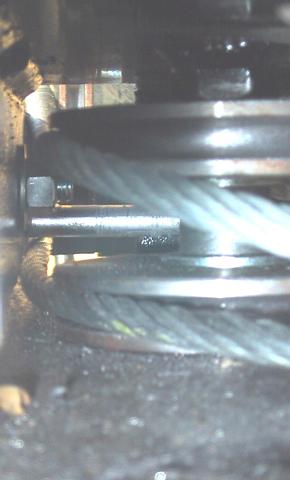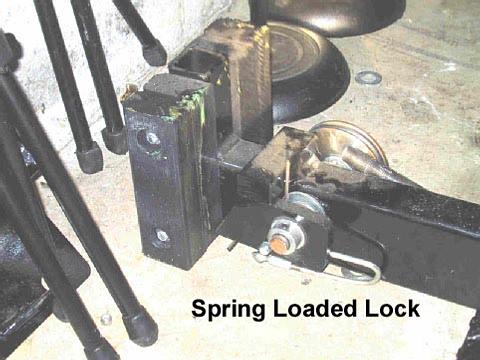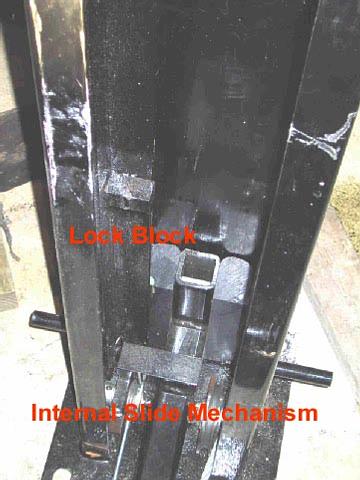After review of the failure that occurred to my
Perfect Park 7000 lift on March 15, I believe I have
determined the cause. Or should I say causes. The collapse was
caused by a dual failure of the actuation system and the
locking mechanism in the post. The actuation system failure
was diagnosed by the manufacturer, Gemini Auto Lifts, and
appears to be right on.
Actuation System:
The actuation system on virtually all residential 4-post
lifts is comprised of a hydraulic ram that acts on a series of
cables that attach to the top of the posts. The cables run
through pulleys, both under the runways and on the crossbars.
As I said in my earlier post, I had assumed that I had let one
of the cables get slack and that the cable had fallen off the
pulley. This was a logical assumption at the time. After
consulting Gemini, however, they had a different opinion.
This picture shows one of the pulley-packs under the
runway.

A stud is installed up into the runway, and the pulleys are
installed with brass bushings and a brass spacer. Then the
stud is capped off underneath the runway with a nut, which is
secured by either locktite or weld (hard to tell which).
Gemini suggested that damage/wear to the bushings could cause
galling on the stud/axle. They surmised that friction between
the pulley and the axle/stud caused the stud to back out of
the runway, allowing the pulley to separate. One of my
pictures taken the day after the collapse suggests validity to
that theory.

Removing the stud and inspecting it, showed the galling and
damage Gemini expected:

Owners and operators of all residential 4-post lifts need
to understand that this pulley-pack design is not unique to
Perfect Park Lifts. They all have an identical or very similar
configuration. After talking with a friend who recently
replaced the bushings in his Stinger lift, I advise that all
of you inspect your axle studs/bolts and bushings.
Understanding this failure, what prevented the post from
locking?
Locking System:
The lock blocks in the posts, combined with spring-loaded
lock mechanism are supposed to assure positive engagement of
the locks should a malfunction of the actuation system occur.
In general it is a well conceived design that should provide
plenty of safety. Again, this concept is not unique to the
Perfect Park. Perfect Park is unique because of the enclosed
slider track, pulleys, cable, and locking mechanism, provided
by creating a 3-sided box column. Most others are exposed. The
locking mechanism with the column removed is shown below, as
is the locking mechanism of a competitorís lift (thanks paso)
so you can see how the locks engage.:


With the column installed it looks like this:

As you can imagine, as the lift elevates in its track the
lock tangs scrape against the lock blocks and snap into place
via spring pressure. When operating the lift, one can hear the
locks engage at each stop. If they donít all snap at the same
time it suggests that the cables need adjustment. Obviously,
it is reasonable to assume that the lift will show signs of
wear on the blocks after several uses. This is certainly not a
bad thing, and in fact should be seen as a source of
confidence. I had my lift for about a year and when I
inspected the inside of my columns I saw the telltale wear on
the blocks Ė on the 2 rear columns that engaged. The front
column (the one that collapsed) showed very little wear on the
blocks. (Pics coming later today - check back). The
other front column could not be inspected because itís on its
side with the lift laying on it. The lack of wear suggests to
me that the column that failed had probably not been strongly
engaging all along. Obviously, when the lift is lowered onto
the lock blocks the tang of the lock would be pulled into the
locked condition if there was positive engagement (adequate
overlap between the tang and the block). If there was NOT
adequate overlap the tang would remain unengaged, and thus,
unlocked. This seems to have been what happened in the case of
my collapse.
It is unclear to me why the one column showed significantly
less wear. I suppose it could be a tolerance buildup,
defective spring, or binding in the linkage.
What to do if you own a 4-post lift?
If EITHER the hydraulic/cable system OR the column locks
had operated as designed my lift would not have collapsed.
Both needed to occur to get the outcome I experienced. That
said, I would:
- Inspect your axle studs/bolts and bushings for
wear/damage
- Ask your manufacturer and ask if there are
inspection or lubrication requirements on the bushings.
-
Ask your manufacturer and ask if there are any product
improvements that could increase the safety of your lift.
-
Inspect your locking mechanism to see that the locks are
ALWAYS positively engaging.
- Periodically check your axle
studs/bolts (and any other related hardware) for tightness.
This summary is not an indictment of Perfect Park or any
other 4-post lift. As Iíve stated before, a lift is a tool,
and should be treated with care and respect. My incident,
hopefully, will lead to product improvements by the industry
and greater awareness by the operator.
[Modified by
69L71, 2:02 PM 4/3/2002]
_______
69 350-350
Burgundy/Saddle Convertible - Loaded (For Sale) Click here for Pics
69 427-435
Black/black coupe, 4spd, 4.11 rear (Under Restoration) Click here for Pics
96' Black/Black LT4

Yeah, I'm the poor schmuck who's lift fell down. Lift Collapse Pics - Click here.
Previous Posts on the
Subject:
[URL][/http://forums.corvetteforum.com/zerothread?id=258483[/URL]
[URL] http://forums.corvetteforum.com/zerothread?id=260941[/URL]
C4s have that cute little Jennifer Love Hewitt butt
while the C5 looks more like J. Lopez

